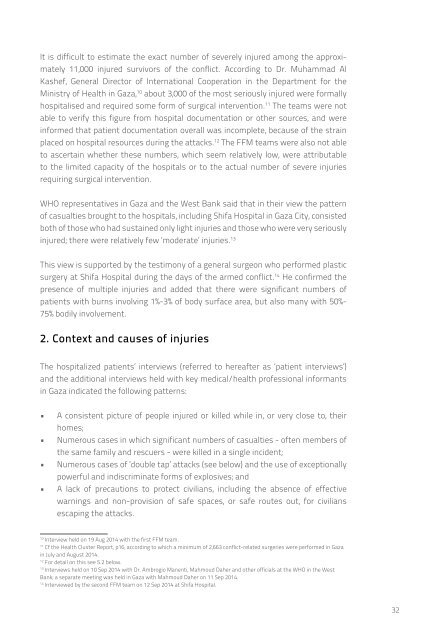HHo0s
HHo0s
HHo0s
You also want an ePaper? Increase the reach of your titles
YUMPU automatically turns print PDFs into web optimized ePapers that Google loves.
It is difficult to estimate the exact number of severely injured among the approximately11,000 injured survivors of the conflict. According to Dr. Muhammad AlKashef, General Director of International Cooperation in the Department for theMinistry of Health in Gaza, 10 about 3,000 of the most seriously injured were formallyhospitalised and required some form of surgical intervention. 11 The teams were notable to verify this figure from hospital documentation or other sources, and wereinformed that patient documentation overall was incomplete, because of the strainplaced on hospital resources during the attacks. 12 The FFM teams were also not ableto ascertain whether these numbers, which seem relatively low, were attributableto the limited capacity of the hospitals or to the actual number of severe injuriesrequiring surgical intervention.WHO representatives in Gaza and the West Bank said that in their view the patternof casualties brought to the hospitals, including Shifa Hospital in Gaza City, consistedboth of those who had sustained only light injuries and those who were very seriouslyinjured; there were relatively few ‘moderate’ injuries. 13This view is supported by the testimony of a general surgeon who performed plasticsurgery at Shifa Hospital during the days of the armed conflict. 14 He confirmed thepresence of multiple injuries and added that there were significant numbers ofpatients with burns involving 1%-3% of body surface area, but also many with 50%-75% bodily involvement.2. Context and causes of injuriesThe hospitalized patients’ interviews (referred to hereafter as ‘patient interviews’)and the additional interviews held with key medical/health professional informantsin Gaza indicated the following patterns:• A consistent picture of people injured or killed while in, or very close to, theirhomes;• Numerous cases in which significant numbers of casualties - often members ofthe same family and rescuers - were killed in a single incident;• Numerous cases of ‘double tap’ attacks (see below) and the use of exceptionallypowerful and indiscriminate forms of explosives; and• A lack of precautions to protect civilians, including the absence of effectivewarnings and non-provision of safe spaces, or safe routes out, for civiliansescaping the attacks.10Interview held on 19 Aug 2014 with the first FFM team.11Cf the Health Cluster Report, p16, according to which a minimum of 2,663 conflict-related surgeries were performed in Gazain July and August 2014.12For detail on this see 5.2 below.13Interviews held on 10 Sep 2014 with Dr. Ambrogio Manenti, Mahmoud Daher and other officials at the WHO in the WestBank; a separate meeting was held in Gaza with Mahmoud Daher on 11 Sep 2014.14Interviewed by the second FFM team on 12 Sep 2014 at Shifa Hospital.32


